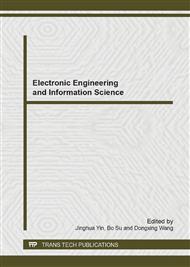[1]
R. Hashmat,P. Pagani, T. Chonavel and A. Zeddam: A Time-Domain Model of Background Noise for In-Home MIMO PLC Networks. IEEE Transactions on Power Delivery, Vol. 27 (2012) No. 4, p.2082-(2089).
DOI: 10.1109/tpwrd.2012.2207744
Google Scholar
[2]
W. Cai, J. Le, C. Jin, et al: Overview of the channel modeling methods of power line carrier communication . Power System Protection and Control, Vol. 40 (2012) No. 10, pp.149-154.
Google Scholar
[3]
H.L. Liu , B.H. Zhang, L.N. Tan: Research On The Channel Capacity In A Low Voltage Network Channel . Automation of Electric Power Systems, Vol. 28 (2004) No. 4, pp.40-44.
Google Scholar
[4]
G. Athanasios, Lazaropoulos and P. G. Cottis: Capacity of Overhead Medium Voltage Power Line Communication Channels. IEEE TRANSACTIONS ON POWER DELIVERY, Vol. 25 (2010) No. 2, pp.723-733.
DOI: 10.1109/tpwrd.2009.2034907
Google Scholar
[5]
P. Amirshahi, S. M. Navidpour, and M. Kavehrad: Performance analysis of uncoded and coded OFDM broadband transmission over low voltage power-line channels with impulsive noise . IEEE Trans. Power Del., Vol. 21 (2006) No. 4, p.1927-(1934).
DOI: 10.1109/tpwrd.2006.877073
Google Scholar
[6]
Y. H. Ma, P. L. So, and E. Gunawan: Performance analysis of OFDM systems for broadband power line communications under impulsive noise and multi-path effects. IEEE Trans. Power Del., Vol. 20 (2005) No. 2, p.674–682.
DOI: 10.1109/tpwrd.2005.844320
Google Scholar
[7]
H.T. Liu , B.H. Zhang, L.N. Tan: Research On The Channel Capacity In A Low Voltage Network Channel . Automation of Electric Power Systems, Vol. 28 (2004) No. 4, pp.40-44.
Google Scholar
[8]
W.L. Luo, X/K. Ke, M. Ma: Study of channel capacity for low voltage power-line based on monte carlo simulation . Chinese Journal of Radio Science, Vol. 24 (2009) No. 4, pp.691-696.
Google Scholar
[9]
J. Jiho K.B. Lee and Y.H. Lee: IEEE GLOBECOM'2003 (San Francisco, USA Proc. Dec 2003)Vol. 2, pp.858-862.
Google Scholar
[10]
H.B. Xu, H. Tian Y.J. Gao and P. Zhang: Wireless Communications and Networking Conference 2008 ( Las Vega, USA, April 2008)Vol. 1, pp.1838-1843.
Google Scholar
[11]
X. Geng Y.H. Li: Analysis for channel characteristics and research for channel model of low voltage power line communication. Power System Communication, Vol. 4 (2004), pp.19-21.
Google Scholar
[12]
J. Anatory, N. Theethayi, R. Thottappillil: Channel Characterization for Indoor Power-Line Networks . IEEE Transaction on power delivery, Vol. 24 (2009) No. 4, pp.1883-188.
DOI: 10.1109/tpwrd.2009.2021044
Google Scholar
[13]
J.G. Proakis: Dagital Communications. 4th ed. (New York, USA , Nov 2001)Vol. 1, pp.191-203.
Google Scholar


